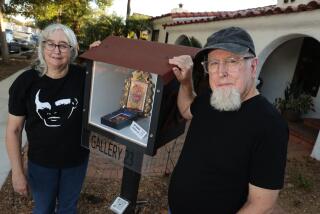Martin Lawrence Brings ‘Fine Art’ to the Masses
- Share via
Martin Blinder, chairman of Martin Lawrence Limited Editions, gently lifts the Plexiglas cover to show off his latest collectible: a 79-cent box of Campbell’s dried chicken noodle soup. What makes this box different from those on a grocer’s shelf is that artist Andy Warhol has signed it.
“It’s now a piece of art,” Blinder said. “And I probably could sell it for $500.”
Blinder’s Van Nuys-based company, which operates a chain of art galleries, didn’t grow into a $10-million business by selling boxes of soup. But conventional thinking is not his style. When he sells lithographs, silk-screen prints, etchings and sculptures, he skips the museum crowd and aims for high volume.
“I want to sell fine art to the masses,” he said. By fine art, he means lithographs or silk-screens by Warhol, Joan Miro and other famous artists, along with sculptures, etchings and silk-screens by lesser-known artists.
To reach the masses, most of Blinder’s 12 art galleries, seven of them in Southern California, are in shopping malls.
There is no sticker shock at a Martin Lawrence gallery. Blinder breaks from tradition because every piece of art in his stores can be taken home for a 20% down payment, and (on average) 27 monthly payments. If you like an Andy Warhol silk-screen of Gertrude Stein, it’s yours for $550 down and $92 a month (at 19.2% interest).
At these prices, Martin Lawrence galleries are a major step below an expensive Beverly Hills gallery, of course, but a big step up from poster shops.
“I took a product like fine art and market it in a way that I would market furniture,” Blinder said.
The art establishment has some doubts about the long-term investment value of what Blinder sells. But Blinder snubs his nose at the “snooty” art crowd, and happily advertises on TV shows, including “The Price Is Right,” “Let’s Make a Deal” and “Wheel of Fortune,” where his art is given away as prizes.
The only art form the stock market cares about, of course, is the profit curve. Blake Childs, an analyst with Bateman Eichler, Hill Richards, expects Martin Lawrence to post record sales of $10.2 million and record profit of $880,000 for the fiscal year ended Dec. 31, a big jump from 1985 results of $6 million in sales and $265,742 in profit. Martin Lawrence’s stock has also been on the rise.
As the company grows, Martin Blinder has also moved away from the long shadow of his father, Meyer Blinder, the penny stock “prince” of Denver, who has had a running battle with the Securities and Exchange Commission.
Meyer Blinder played a key role in his son’s company, making a $200,000 no-interest loan to Martin Lawrence Limited Editions several years ago. In January, 1985, Meyer Blinder’s brokerage firm, Blinder, Robinson, took Martin Lawrence public. The sale of stock, and warrants that were later exercised, raised $3.25 million to help finance the art company’s expansion. And Blinder, Robinson has been the chief trader in Martin Lawrence’s stock.
Appeal of SEC Move
But the SEC has moved to bar Meyer Blinder from the securities industry for two years, starting in March. Blinder has filed an appeal with the Circuit Court of Appeals in Washington.
Meyer Blinder’s problems date back to 1979 and 1980 when Blinder, Robinson sold stock in an Atlantic City casino and hotel, and, the SEC maintains, made fraudulent stock predictions to the public.
Penny stocks, so-called because the stock price is usually $1 or less, involve companies with a short financial history, and the stocks tend to be extremely volatile.
There has never been any suggestion of impropriety between Martin Lawrence Limited Editions and Blinder, Robinson, but analysts say the close relationship probably hurt Martin Lawrence’s reputation.
“Martin Lawrence may not have gotten as much coverage from the investment community as it deserved,” said analyst Frank Podbelsek of Wedbush, Noble, Cooke.
Martin Blinder, now 40, went into the art business after a brief career as a stock broker (“When a stock went down, I was sick.”) He caught the art bug and became a collector, then, to pay for his habit, became an art publisher in 1974.
A publisher makes an agreement with an artist to distribute the entire run of a given lithograph or etching, and sells them wholesale to art dealers. By 1981, Blinder’s wholesale business was doing $3 million a year in sales.
In 1981, Blinder opened an art gallery in the Sherman Oaks Galleria. He enjoyed being able to sell the same lithographs to the public for $1,000 at retail that he sold wholesale to art dealers for $500.
Blinder kept refining his marketing formula. He lined up General Electric Credit Corp. to handle credit financing. To build traffic in his stores, Blinder offered silk-screens and etchings by name artists, such as Marc Chagall and Peter Max, as well as works by younger ones, such as Susan Rios and Doug Webb.
$1,500 Average Sale
His stores are not the places to look for one-of-a-kind oil paintings. They emphasize silk-screens and etchings that may have a run of 500.
Blinder’s average sale goes for $1,500. Customers fit the yuppie mold--between the ages of 25 and 45, and earning more than $35,000 a year.
Blinder is continuing to branch out from California and is opening a gallery in Manhattan’s Soho, one of the country’s foremost art districts. He talks of the company’s tripling in size within three years.
Analysts caution that a recession could hurt the company’s sales. And there is also the worry of trying to expand too fast.
But Blinder is convinced. “We have found a formula,” he said. “Everybody is a collector of some sort. Nobody has blank walls.”
More to Read
The biggest entertainment stories
Get our big stories about Hollywood, film, television, music, arts, culture and more right in your inbox as soon as they publish.
You may occasionally receive promotional content from the Los Angeles Times.











